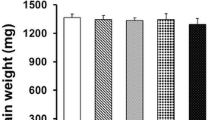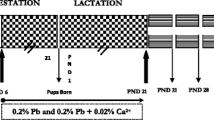Abstract
Pregnant rats were treated with 0.4% lead acetate through drinking water from 6th day of gestation and this treatment was continued till 21 post natal days (PND). Four regions of the brain namely hippocampus, cerebellum, frontal cortex and brain stem were dissected at 10, 20, 30 and 40 PND for estimation of lipid peroxidation products (LPP), catalase (CAT) and superoxide dismutase (SOD). The results indicate that there was a significant (P < 0.05) increase of LPP in exposed rats than their corresponding control at 10, 20 and 30 PND both in hippocampus and cerebellum. At PND 40, the LPP of control and exposed were found to be almost same in both the tissues indicating recovery from lead toxicity. CAT activity was significantly (P < 0.05) high in hippocampus of exposed rats up to PND 30 but up to PND 20 in cerebellum and frontal cortex. However, in brain stem, a significant (P < 0.05) increase in CAT activity was observed only at PND 10. A significant (P < 0.05) increase in SOD activity was observed up to PND 30 both in hippocampus and cerebellum on lead exposure. Frontal cortex exhibited a similar significant (P < 0.05) increase of SOD activity up to PND 20 and for brain stem up to PND 10. There was no significant change in the activity of antioxidant enzymes (CAT and SOD) and LPP in all the four brain tissues of control and exposed rats at PND 40 indicating recovery from lead-induced oxidative stress.



Similar content being viewed by others
References
Adonaylo VN, Oteiza PI (1999) Lead promotes lipid oxidation and alterations in membrane physical properties. Toxicology 132:19–32
Aebi H, Packer L (1984) Catalase in vitro. Methods Enzymol 105:121–126
Altmann L, Weinsberg F, Seinsson L, Llienthal H, Wiegand H, Winneke G (1993) Impairment of long term potentiation and learning following chronic lead. Toxicol Lett 66:105–112
Bachara EJH, Mediros MHG, Monteiro HP, Hermes-Lima M, Pereira B, Demasi M, Costa CA, Abdullah DSP, Onuki J, Wendel CMA, Di Mascio P (1993) A free radical hypothesis of lead poisoning and inborn porphyries associated with 5-aminolevulenic acid overload. Quirn Nova 16:385–392
Beauchamp PC, Fridovich I (1971) Superoxide dismutase: improved assay and an assay applicable to PAGE. Analyt Biochem 44:276–287
Bolin CM, Basha R, Cox D, Zawia NH, Maloney B, Lahiri DK, Cardozo-Palaez F (2006) Exposure to lead and the developmental origin of oxidative DNA damage in the aging brain. FASEB J 20:788–790
Burdette LJ, Goldstein R (1986) Long term behavioural and electrophysiological changes associated with lead exposure at different stages of brain development in the rat. Dev Brain Res 29:101–110
Devi CB, Reddy GH, Prasanthi RP, Chetty CS, Reddy GR (2005) Developmental lead exposure alters mitochondrial monoamine oxidase and synaptosomal catecholamine levels in rat brain. Int J Dev Neurosci 23:375–381
Ercal N, Teratphan RH, Grannermann NH, Spitz DR (1996) In vivo indices of oxidative stress in lead induced C57BL/6 mice are reduced by the treatment with meso-2 3-dimercatosuccinic acid or N-acetyl cysteine. Free Rad Biol Med 21:157–161
Garza A, Vega R, Soto E (2006) Cellular mechanisms of lead neurotoxicity. Med Sci Monit 12:57–65
Gerber GB, Maes J (1978) Increased ALA dehydratase activity and spleen weight in lead intoxicated rats. A consequence of increased blood cell destruction. J Experimentia 34:381–382
Goyer RA (1993) Lead toxicity: current concerns. Environ Health Perspect 86:177–181
Gurer H, Neal R, Yang P, Oztezcan S, Ercal N (1999) Capotril as an antioxidant in lead—fisher 344 rats. Hum Exp Toxicol 18:27–32
Gurer H, Ozgunes H, Neal R, Spitzand DR, Ercal N (1998) Antioxidant effects of N-acetyl cysteine and succimer in red blood cells from lead exposed rats. Toxicology 128:181–189
Halliwell B (1994) Free radicals, antioxidants, and human disease: curiosity, cause and consequences. Lancet 344:721–724
Halliwell B, Gutteridge JMC (1989) Free radicals in biology and medicine. Clarendon press, Oxford
Hiroshi O, Ohisi N, Yagi K (1979) Assay for lipid peroxides in animal tissues by TBA reaction. Anal Biochem 95:351–358
Jiun YS, Hsien LT (1994) Lipid peroxidation in workers exposed to lead. Arch Environ Health 49:256–259
Klassen CD (1990) Heavy metals and heavy metal antagonist. In: Gilman TW, Nies A, Taylor P (eds) Goodman and Gilman’s the pharmacological basis of therapeutics. Pergamon Press, New York, pp 1592–1614
Kodavanti PRS (1999) Reactive oxygen species and antioxidant homeostasis in neurotoxicology. In: Tilson HA, Harry GJ (eds) Neurotoxicology. Taylor & Francis Press, USA
Lima-Hermes M, Pereira B, Bechara EJH (1991) Are free radicals involved in lead poisoning? Xenobiotica 21:1085–1090
Lockitch G (1993) Perspectives on lead toxicity. Clin Biochem 26:371–381
Monteiro H, Abdullah D, Arcuri A, Bechara E (1995) Oxygen toxicity related to exposure to lead. Clin Chem 31:1673–1676
Moreira EG, Vassilieff I, Vassilieff VS (2001) Developmental lead exposure: behaviour alterations in the short and long term. Neurotoxicol Teratol 23:489–495
Oteiza PI, Verstraeten SV, Adonaylo VN (1995) Oxidative damage induced by metals without redox capacity in biological systems. Ci Cult 47:330–335
Patra RC, Swarup D, Dwivedi SK (2001) Antioxidant effects of alpha tocopherol, ascorbic acid and l-methionine on lead induced oxidative stress to the liver, kidney and brain in rats. Toxicology 162:81–88
Reddy GR, Devi BC, Chetty CS (2006) Developmental lead neurotoxicity: alterations in brain cholinergic system. Neurotoxicol (In Press)
Rehman S, Shafiq-ur-Rehman O, Chandre O, Abdullah M (1995) Evaluation of malondialdehyde as an index of lead damage in rat brain homogenates. Biometals 8:275–279
Sandhir R, Julka D, Gill KD (1994) Lipoperoxidative damage on lead treatment in rat brain and its implications on membrane bound enzymes. Pharmacol Toxicol 74:66–71
Selkoe DJ (2001) Alzheimer’s disease: genes, proteins and therapy. Physiol Rev 81:741–766
Snedecor GW, Cochran WG, (1967) Statistical methods. The Iowa State University Press, Iowa
Toscano CD, Guilarte TR (2005) Lead neurotoxicity: from exposure to molecular effects. Brain Res Rev 49:529–554
Villeda-Hernandez J, Barroso-Moguel R, Mendez-Armenta M, Nava-Ruiz C, Huerta-Romero R, Rios C (2001) Enhanced brain regional lipid peroxidation in developing rats exposed to low level lead acetate. Brain Res Bull 55:247–251
Villeda-Hernandez J, Mendez Armenta M, Barroso-Moguel R, Trejo-Solis MC, Guevara J, Rios C (2006) Morphometric analysis of brain lesions in rat fetuses prenatally exposed to low-level lead acetate: correlation with lipid peroxidation. Histol Histopathol 21:609–617
West WL, Knight EM, Edwards CH, Menning M, Spurlock B, James H, Johnson AA, Oyemade UJ, Jackson C, Westney LS (1994) Maternal low level lead and pregnancy outcomes. J Nutri 124:981–996
Shafiqu-ur-Rehman S (1984) Lead induced regional lipid peroxidation in brain. Toxicol Lett 21:333–337
Zawia NH, Basha MR (2005) Environmental risk factors and the developmental basis for Alzheimer’s disease. Rev Neurosci 16:325–337
Zhang Y, Dawson VL, Dawson TM, 2000 Oxidative stress and genetics in the pathogenesis of Parkinson’s disease. Neurobiol Dis 7:240–250
Acknowledgements
This research work was supported by NIH/FIC/MIRT #00132, NIH/NIGMS/MBRS-SCORE #GM55356 awarded to Bettaiya Rajanna at Alcorn State University, Mississippi, USA. Erika Brown and Rashidi McCormick are undergraduate student participants in MIRT Program. The authors thank the authorities of Andhra University for providing research facilities for this international collaboration of undergraduate student research training program.
Author information
Authors and Affiliations
Corresponding author
Additional information
This research work was presented as a poster in Annual Biomedical Research Conference for Minority Students (ABRCMS) at Dallas, Texas, USA, during November 10–13, 2004 and the abstract was printed on page 231 of the Conference Proceedings
Rights and permissions
About this article
Cite this article
Bokara, K.K., Brown, E., McCormick, R. et al. Lead-induced increase in antioxidant enzymes and lipid peroxidation products in developing rat brain. Biometals 21, 9–16 (2008). https://doi.org/10.1007/s10534-007-9088-5
Received:
Accepted:
Published:
Issue Date:
DOI: https://doi.org/10.1007/s10534-007-9088-5




